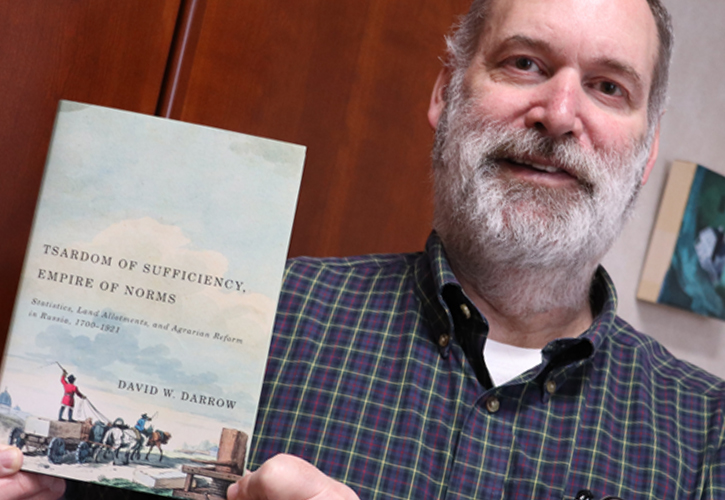College of Arts and Sciences Newsroom

Measuring Human Sufficiency
University of Dayton historian David Darrow’s latest book was inspired by his graduate school roommate, who created a database from census information, in hopes of discovering insights about the population.
“I used to give him a hard time about reducing human life to numbers,” said Darrow, associate professor of history. “That got me thinking about what it means to count people and categorize their lives.”
The result is Tsardom of Sufficiency, Empire of Norms: Statistics, Land Allotments, and Agrarian Reforms in Russia, 1700-1921, published by McGill-Queen’s University Press. The book explores how numbers shaped Russia’s land reform policies from the 18th century to the Civil War, and how they formed a narrative of what the state thought it understood as reality.
Russia’s agrarian system was built on a statistical measure called a “nadel” — a specific allotment of land — as a standard of peasant wellbeing. This land entitlement was seen as a key to social stability for peasants, who were thus guaranteed some level of subsistence.
“It is out of concerns such as these that we get the first institutions and policies of the welfare state in both its western European and its Soviet form,” Darrow said.
During the early 20th century, many of Russia’s landed nobility were eager to sell their estates because of plummeting grain prices and a series of peasant uprisings and revolutions from 1902 to 1907. In the interest of providing peasants with a sufficient nadel, the imperial government empowered the State Peasant Land Bank to purchase noble lands and then resell the tracts to peasants — with the unrealized goal of transforming them into efficient farmers.
After the empire fell in 1917, the Bolsheviks continued to allocate property based on these same traditional land norms during the early years of Soviet power. Their policy remained locked into the idea that peasants needed to have enough land to survive, instead of trying to get them to do more with the land they had.
“In many respects, the norms themselves became a measure of socio-economic justice,” Darrow said. “In rural areas, it was a land norm. In urban areas, it was a norm for living space — a certain number of square meters that every Soviet citizen was entitled to. This was the epitome of modernity: Everything can be measured and once you can measure something, then in the interest of equality you can mete it out by some sort of measure.”
Darrow researched Tsardom of Sufficiency, Empire of Norms over eight years, including a 2016 sabbatical. He examined archival sources and rural councils’ statistical studies in Moscow and St. Petersburg, Russia. In addition to writing the book, he has translated that research experience to the classroom.
“One of the things I like about the University of Dayton is the emphasis on the teacher-scholar model,” he said. “I believe that an active life of scholarship informs a classroom and keeps you up to date on the latest scholarship on your topic. If you take Russian history from me, you hear a lot about agriculture and peasants, and that in many respects comes out of my work here.”
Darrow, who has served as director of both the International Studies and University Honors programs, also leads periodic summer trips to Russia for undergraduate students.
He recalled waxing poetic about the wonders of being in an archive to students in Introduction to the Historian’s Craft, a core course for history majors, after returning from sabbatical. Excited by his words, one student asked why they, too, couldn’t be in an archive.
“That ultimately led to what we are doing now, both in the introduction and our senior capstone course, which is getting our history majors into the University archives and the Marianist Library, working on research projects with the primary sources available there.”
To date, these senior capstone research projects have resulted in student-created websites dedicated to the history of both UD Arena and the Dayton Arcade.
“Since coming to the University of Dayton more than two decades ago, Dr. Darrow has been an extremely active scholar, exceptional teacher in the classroom, and generous colleague in the department,” said Juan Santamarina, associate professor and Department of History chair. “Always informed by his scholarship, Dr. Darrow is quick to remind us of historical context, statistical interpretations and the creation of realities based on constructed knowledge.”
- Dave Larsen, communication coordinator, College of Arts and Sciences
